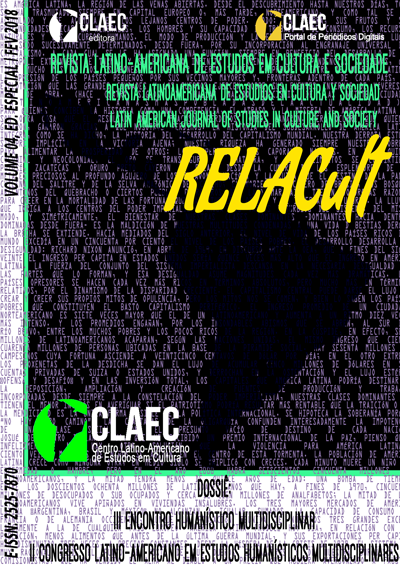REFLEXÕES SOBRE A RODA DE MEMÓRIA COMO FONTE PARA O ESTUDO DO PATRIMÔNIO INDUSTRIAL USINA TERMOELÉTRICA CANDIOTA I
DOI:
https://doi.org/10.23899/relacult.v4i0.743Keywords:
Patrimônio industrial, Usina Candiota I, MemóriaAbstract
Este trabalho analisa a importância do patrimônio industrial Usina Candiota I, especialmente no que se refere às indústrias carboníferas para o município de Candiota (RS). O Centro Cultural Candiota I, o remanescente do antigo complexo carbonífero, situado no pampa gaúcho, no município de Candiota. O local que abrigou um segmento da indústria sul rio-grandense, a indústria carbonífera. O município é conhecido nacionalmente por seu potencial industrial, principalmente no setor carbonífero. Contudo essa realidade, já conta com algumas décadas de história que pode ser contada a partir das memórias dos primeiros operários, que iniciaram suas atividades durante a década de 1960. O presente trabalho objetiva explorar como a roda de memória pode salvaguardar o patrimônio industrial baseado no exemplo de Candiota. Buscamos, em primeiro momento refletir sobre possíveis contribuições da roda de memória para a preservação do patrimônio industrial.
References
BOM MEIHY, José e HOLANDA, Fabíola. História Oral: como fazer, como pensar. São Paulo: Contexto, 2007.
BRASIL. Instituto Brasileiro de Geografia e Estatística (IBGE). Histórico da cidade de Candiota. IBGE Cidades, 2011.
Disponível:<http://www.ibge.gov.br/cidadesat/topwindow.htm?1>
Acesso: 15.08.2017.
CANDAU, Joel. Memória e identidade. 3ºed.(trad. Maria Letícia M. Ferreira). São Paulo: Contexto, 2016.
DENCKER, Ada de Freitas Maneti. Pesquisa em turismo: Planejamento, Métodos e Técnicas. São Paulo: Futura, 1998.
FERREIRA, Maria Letícia Mazzucchi. Patrimônio industrial: lugares de trabalho, lugares de memória. Museologia e patrimônio, Rio de Janeiro, v.2, n.1, p.22-34, jan./jun.2009<.http://revistamuseologiaepatrimonio.mast.br/index.php/ppgpmus/article/viewFile/43/23> Acesso: 28.05.2017.
FRANÇOIS, ETTIENNE. As novas relações entre memória e História após a queda do muro de Berlim. Memória em Rede, v 2, n 2,2010. Disponível: <https://periodicos.ufpel.edu.br/ojs2/index.php/Memoria/article/view/9553/6393>Acesso: 09.12.2017.
GIL, Antônio Carlos. Como elaborar os projetos de pesquisa. 4º ed. São Paulo: Atlas, 2002.
IPHAE/RS. Bem Tombado: Candiota I. Disponível:<http://www.iphae.rs.gov.br/Main.php?do=BensTombadosDetalhesAc&item=47601> Acesso em: 22.01.2017.
SILVA e MELLO, Leonardo . Patrimônio industrial: passado e presente. Revista eletrônica do Iphan. São Paulo, 2006. Disponível em: http://portal.iphan.gov.br/uploads/publicacao/patrimonio_industrial_passado_e_presente.pdf> Acessado: 24.11.2017.
THE INTERNATIONAL COMMITTEE FOR THE CONSERVATION OF THE INDUSTRIAL HERITAGE (TICCIH). Carta de Nizhny Tagil sobre o patrimônio industrial. Nizhny Tagil, 17 jul. 2003. Disponível em: <http://ticcih.org/wpcontent/uploads/2013/04/NTagilPortuguese.pdf>. Acesso em: 28.09. 2017.
Downloads
Published
Issue
Section
License
Authors who publish in this journal agree to the following terms:
Authors retain the copyright of their works and grant RELACult the right of first publication. All articles are simultaneously licensed under the Creative Commons Attribution 4.0 International (CC BY 4.0), which allows sharing, distribution, copying, adaptation, and commercial use, provided that proper credit is given to the original authorship and the first publication in this journal is acknowledged.
RELACult makes all of its content openly accessible, thereby increasing the visibility and impact of the published works. The contact information provided in the submission system is used exclusively for editorial communication and will not be shared for any other purpose.

